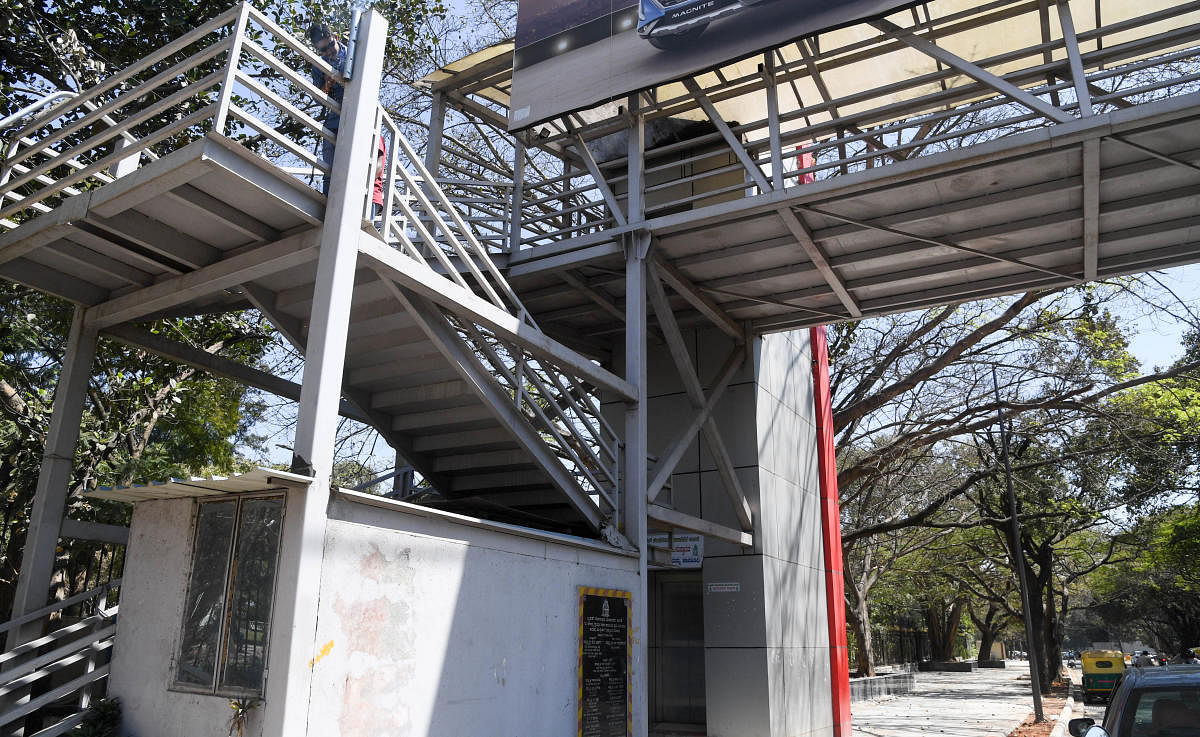

Bypass traffic congestion in a jiffy, breeze past bothersome intersections and those troubling pedestrians in your speedy, motorised wonder machines. This is the promise of the signal-free corridor, a project sold to ordinary Bengalureans as so revolutionary that it could be the next big thing after the flyover!
But what about the poor pedestrians, the senior citizens, the disabled? The standard, official response is this: They could take the skywalks, those fancy, imposing up-in-the-air marvels. And if they find these structures too high to climb, they could take the elevators.
However, there is a problem. On Old Airport Road, where the first of the corridors is taking shape, skywalks are sprouting everywhere. But beyond the space allotted for it, no elevator has been installed. Will things change once these structures are integrated?
Lifts in disrepair
No, and here’s why: Skywalk elevators across the city are in bad shape. Either they are in disrepair, in lock and key or without power. Meanwhile, the elevated structures remain grossly under-utlised, poorly placed and notoriously inaccessible.
A skywalk in Yeswanthpura has an elevator but remains closed. Another near the Jawaharlal Nehru Planetarium has stopped functioning. A third lift fitted to a skywalk in Murugeshpalya is shut as well. An escalator has taken the place of an elevator near Orion Mall. But this too has stopped functioning.
Before venturing deeper into this troubling issue, what exactly is this signal-free corridor that has got all the motorists excited? To get a glimpse of this unfolding magic solution, DH takes a reality ride.
Congestion-killer?
First, the project details: At a cost of Rs 109.5 crore, the 17.5 km corridor is being built by the Bruhath Bengaluru Mahanagara Palike (BBMP). Once complete, they say this would morph into a congestion-killer, helping Old Airport Road motorists get from Vellara Junction to Hope Farm Junction in quick time, without wasting a single minute at a signalled intersection.
Perfect, so why complain? Mobility experts ask a counter question: When barricades are up everywhere, how do pedestrians get across the road? Why should senior citizens, the weak and the disabled be forced to climb at all when they could just walk across at an intersection?
It is a policy problem. Traditionally, the motorist has remained the road king. The pedestrian and the cyclist have always been on the periphery. By its very nature, a signal-free corridor favours the car owner, the motorists on multiple wheels.
A bad move
From an urban planning and healthy city perspective, this is a bad move, says Jaya Dhindaw, Bengaluru Project Chief at the World Resources Institute (WRI). “Getting people not to move at grade, but up and down… The whole thinking itself is flawed. You are endangering senior citizens and the disabled, people who are part of the vulnerable sections of the population.”
The political economy of cities here is built around private car owners and motorcyclists, she points out. “Seventy per cent of the people walk, cycle and use public transport. But public policy is built around 10% who use their own vehicles. The policy should be oriented towards moving people and not moving vehicles.”
Reality check
So, when the signal-free corridor finally opens and the vehicles breeze past at high speeds, pedestrian crossings will have to literally go up to the next level. In theory, this looks fine. But the DH reality check and past experience of skywalks elsewhere show the nightmare will start showing up in months if not weeks.
Jay-walking is routine even on heavily barricaded city streets. Once the signalled intersections disappear and skywalks turn inaccessible, this dangerous road-crossing will become the norm, warns seasoned transport engineering mobility expert Ashish Varma from the Indian Institute of Science (IISc).
Since the corridor will ensure an obstacles-free ride, vehicular speeds can get extremely high. This will make at-grade, random pedestrian crossings doubly risky.
Inner-city roads
Arterial roads turning signal-free to aid quicker exit of vehicles heading out of the city might have a rationale. But can this apply to inner city roads that cut across highly congested residential areas?
The Old Airport Road, for instance, is flanked by Konena Agrahara, Murugeshpalya, Domalur, Marathahalli and other areas with very high pedestrian movement.
Ultimately, the vehicles speeding on these corridors will get stuck in some intersection ahead. “In Yeswanthpura, the flyover that takes off at CNR Circle dumps all the traffic at Peenya, creating a bottleneck there. Corridors and flyovers simply shift congestion from one junction to another. These are all flawed concepts,” says Varma.